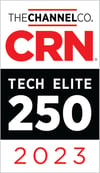For companies that are looking to progress along their digital transformation journey, adopting software-defined infrastructure is a great option. Implementing software-defined storage (SDS) can be the jumping-off point for moving toward a software-defined data center (SDDC).
Software-defined storage is a storage architecture in which the storage software is separated or abstracted from the hardware layer. SDS represents how storage technology has evolved from traditional hardware-based storage area network (SAN) and network-attached storage (NAS) approaches to operate independently of hardware.
Separating the software layer from the hardware layer has many advantages for companies that want to modernize their data storage and management.
Here’s an overview of 5 main benefits of SDS:
1) Enhanced data management
SDS is a software layer between hardware and data requests that centralizes and enhances data management. This software layer enables companies to manage how and where data is stored.
The programmability of SDS allows for the management of both structured and unstructured data. Data can be tiered according to frequency of access for more efficient use of storage resources. SDS can also carry out data deduplication and compression processes for better capacity management.
2) AI-powered automation for data resilience
Using intelligent software, SDS can orchestrate and automate storage management tasks associated with data resilience. Data resilience means that, after a traumatic event, such as a data breach, a company can bounce back by restoring its data quickly, completely, and accurately.
The programmability of SDS allows companies to use automation to carry out data backup and recovery, the backbone of data resilience. With SDS, AI-powered automation carries out predictive analytics to assess data health and conduct proactive threat detection and response to prevent data from being stolen or compromised.
3) Scalability
SDS is highly scalable because the software layer is abstracted from the hardware layer. Companies can scale their storage resources on demand without the need to provision additional hardware. Instead, users can remove storage capacity from inflexible hardware and put it in one flexible and scalable place.
With SDS, businesses can scale both vertically, by increasing power to meet the performance demands of workloads, and horizontally, by increasing the capacity needed to store data. This elastic scalability empowers organizations to handle increased workloads seamlessly without interruptions to workloads.
4) Flexibility
SDS provides a flexible foundation for data storage. The technology supports on-premises, hybrid cloud, and multicloud environments, as well as containerization for application development.
Through dynamic resource allocation, SDS ensures that a company’s storage architecture, including existing hardware in some cases, is flexible and agile enough to accommodate changing workload requirements and digital transformation initiatives. SDS can support traditional, next-generation, and cloud-native applications.
5) High availability
SDS promotes high levels of availability by allowing companies to store data across environments, whether in the cloud, on premises, or at geographically distributed locations. As a distributed storage platform, SDS creates fault tolerance and redundancy by enabling data to be written to multiple locations at the same time. Active-active clusters minimize downtime in the event of a hardware failure, supporting disaster recovery.
Following SDS Implementation Best Practices
Adopting SDS and other software-defined technologies can help your company future-proof your IT environment. However, before implementing SDS, you should follow best practices, including assessing your organizational needs and ensuring that you choose the right SDS solution for your company.
Working with a technology partner that specializes in software-defined solutions will increase your chances of developing smooth migration and deployment strategies for SDS.
ProActive Solutions can help your company follow SDS implementation best practices using our consultative approach. We offer leading SDS technologies and other software-defined solutions as part of our digital transformation solutions.
Find out if software-defined storage is right for your company. Request a consultation from ProActive.



